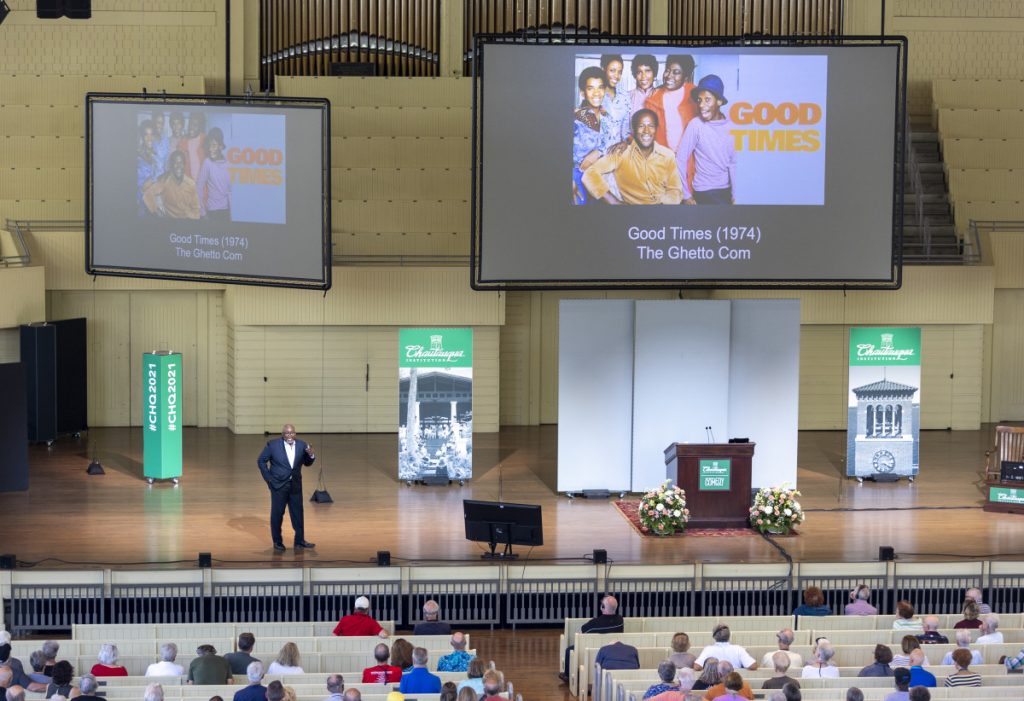NICK DANLAG – STAFF WRITER

Eric Deggans admits he has a cool job. As NPR’s first full-time TV critic, Deggans is paid to watch television and talk to directors and actors.
But he sees the real purpose of his job as more expansive.
“We can really get a sense of how the country feels about race, how we feel about each other, based on what we enjoy, what were big hits, how TV shows were cast, what kind of stories were told,” Deggans said.
“Evoking Oprah,” Deggans asked the Chautauqua crowd why people should care about representation in entertainment. One person said it was because what people watch is what they believe, another said it impacts thoughts and feelings.
Deggans said they were right, but that shows teach society how to dream. An example is how after Morgan Freeman and Dennis Haysbert played the role of president in their respective works, “2012” and “24,” people were able to imagine a Black person as President of the United States.
“These filmmakers were saying to people, ‘In the future, we can imagine we’ll have a Black president,’ and before too long, we had one,” Deggans said. “So it allowed people to vote for a Black president and think it could happen, and it allowed young Black children to look at a candidate for president and think that maybe they knew him, too.”
And TV shows and movies affect how people treat the Other.
“If you are in a moment where you have to make a split-second decision about whether you’re going to apply force or find out more information, the images you have in your head about the person that you’re confronting may have a deep impact on which choice you make,” Deggans said. “These depictions can have very real-world consequences for how much we can dream, who we vote for, what kind of society we have and who rises up, doesn’t, who gets killed, who doesn’t.”
At 10:30 a.m. Tuesday, July 27 in the Amphitheater, Deggans took the crowd on a tour through Black representation in TV shows from the 1950s to modern day and showed how to spot racist stereotypes and caricatures. His lecture, titled “The List: The History of Black Voice and Image in TV Comedy,” was the second of the Chautauqua Lecture Series’ Week Five theme, in partnership with the National Comedy Center, on “The Authentic Comedic Voice.”

The 1950s and “Beulah”
The list started in the 1950s with Hattie McDaniel in “Beulah,” a show about a Black woman who is the maid to the 1950s’ version of the perfect American family.
“Perfect maid, unquestionably happy,” Deggans said.
Deggans said Beulah was a “mammy figure,” a stereotype based on the jobs often forced on Black enslaved women. This stereotype is depicted as an overweight, dark-skinned caregiver who serves white children more than her own, with a “deference to white glory.”
Another stereotype in this decade of TV shows was the “coon figure,” depicting Black men as “happy-go-lucky, childlike, dimwitted, lazy, inarticulate,” and putting the welfare of white people and the white families they serve over their own families’ needs.
“This is a stereotype taken from minstrel shows where white people often dressed in blackface to portray Black characters: dark skin, white lips,” Deggans said.
One show in the 1960s, “Amos ‘n’ Andy,” was popular with white audiences but was ultimately canceled due to numerous complaints from the NAACP about this stereotype being used.
One of the show’s problems was that it did not have any white characters.
“They lived in an all-Black world and there were no white people, so they didn’t even have to deal with the deference to white authority, or the difference between Black life and white life,” Deggans said.
This show established the trend of casting Black people in comedy.
“It established comedy as a nonthreatening venue for showing people of color,” Deggans said. “There’s been a sense that until relatively recently, people of color are more often shown in TV comedies because that’s a nonthreatening venue; in dramas, you have to take those characters more seriously.”
Deggans said this left actors between a rock and a hard place; they knew they were portraying racist stereotypes, but there were no other acting jobs for Black people.
He then paraphrased McDaniel, who herself was the first woman to win an Oscar with her performance in “Gone with the Wind,” who said she would rather be paid $800 a week for playing a maid than paid $70 for being one.

The 1960s and 1970s
When the ‘60s rolled around, many white producers wanted to reverse the stereotypes of the previous decade. While Deggans said these white producers were well-meaning, they created a new stereotype, which he called “The Super Negro.” He said this character is often extremely talented, so there is no question that they should be welcomed into white society.
He said these characters are divorced from Black culture and often have no Black family or friends that appear in the show. In “Julia,” the title character only is around white people, the plot glosses over race issues, and the audience accepted the show because it was more of a reflection of white culture than Black culture.
Deggans then talked about the ‘70s and “Ghetto Coms” — sitcoms about Black families who lived in poor areas.
“I loved ‘Good Times’ when I was growing up. I grew up in Gary, Indiana, and I grew up in a house where my dad wasn’t around; my parents had split up before I was born,” Deggans said. “To see a show of a Black family with a Black father in the house doing his best to take care of his family, working hard, was really important.”
Deggans said that this era of TV often addressed realities of problems, such as lack of money, and Black actors starred in lead roles. The negatives, however, were that this era was still full of many stereotypes, such as the “coon figure” and abusive Black fathers, and portrayed ghettos to be safe, fun places.
In “Good Times,” the character J.J. Evans was popular with white fans, but Deggans critiqued him as a “coon figure.” The character was written as dimwitted and greedy, with barely any other characterization. The cast of “Good Times” even critiqued the show because actors Esther Rolle and John Amos were promised by producers that the show would be progressive. Amos was later fired for arguing too much with producers.
The 1980s and 1990s
The theme of Black representation in the 1980s was respectability politics.
“So what respectability politics are, is this idea that in order for Black people and nonwhite people to succeed in America, they need to conform to America’s idea, white America’s idea, of what being upwardly mobile and successful is,” Deggans said.
To talk about 1980s’ television, Deggans had to talk about Bill Cosby.
“Now, it’s tough to talk about Bill Cosby these days as a pioneer, because he has been convicted (although the conviction was overturned) of some horrible crimes,” Deggans said. “That’s what’s so difficult in talking about Bill Cosby — because he really did have an impact on television,” he said.
In terms of representation of Black people, “The Cosby Show” had positive effects by showing smart, successful, fully-developed Black characters. But the show also largely ignored racism.
“We didn’t see much about systemic racism, prejudice, and it convinces white audiences that if you just work hard and you’re respected, then you can succeed in America, even though Black people know that often is not true,” Deggans said.
The beginning of the 1990s was also the start of counterprogramming. Executives at Fox, in order to compete for advertising views, decided to run shows about people who were different from those on Must See TV on NBC, which had all-white casts.
This was also the time that Deggans began his career in television criticism. He said that he could ask his white coworkers about popular Fox shows like “Martin” and they would have no idea what he was talking about. When he asked his Black friends about “Friends” or “Seinfeld,” they would have the same reaction.
He said it was as if people lived in two different worlds, with two polarized viewing experiences.
Now
When television viewership started to decrease, the industry decided to target specific demographics more directly. Deggans said Black people, proportionally, watch TV more than any other demographic, and, within Black families, he said Black women most often make purchasing decisions.
Despite many steps in the right direction, racist stereotypes are still depicted on television. Deggans gave four ways to identify a character that falls into a stereotype. The first was if they are primarily defined by their race and no other attributes. The second was if their entire role is to make a sacrifice for white characters.
The third is if the character acts in a stereotypical manner without reason. Sometimes, though, writers will play into a stereotype in order to challenge the audience’s perception, which Donald Glover does many times in his show “Atlanta.”
The last was if they are isolated from other people of their race. A recent example of this is Raj from “The Big Bang Theory,” who Deggans said mainly was shown hanging around an all-white cast, and his own family rarely featured.
Though Black actors, directors and producers are doing great work currently, Deggans did not want to detract from the work of Black actors in the past, even ones who portrayed racist stereotypes.
“Those shows were funny because those performers were funny. And they took these horrifically stereotypical situations, and somehow made them funny,” Deggans said. “I think that’s the story of Black people and comedy on television, for much of its history — is talented Black performers and elevating whatever they get and making them iconic.”
As part of the Q-and-A session, Matt Ewalt, vice president and Emily and Richard Smucker Chair for Education, asked Deggans if there is any shared experience viewing now like there was in the past.
Deggans said the two worlds of television viewership in the ‘90s were a harbinger of things to come. He then asked the crowd if they had seen “M.A.S.H.” and many people raised their hands.
“I love this audience because you guys have seen all these old TV shows that I love.When I’m talking at colleges and I say ‘M.A.S.H.,’ they’re like ‘What?’ ” Deggans said.
The finale of “M.A.S.H.” brought in 109 million viewers. Currently, with many streaming services using subscription models and algorithms that suggest shows based on what the person already watched, Deggans said it is hard to have a society-wide viewing experience.
Though, he said, people can take the initiative to break out of their algorithms by looking up and watching shows they normally wouldn’t experience. Deggans said that people now have more power and choice than any other time, especially with the shows they watch. He then quoted Spiderman’s Uncle Ben: “With great power comes great responsibility.”




